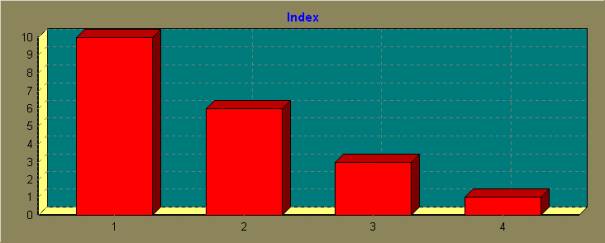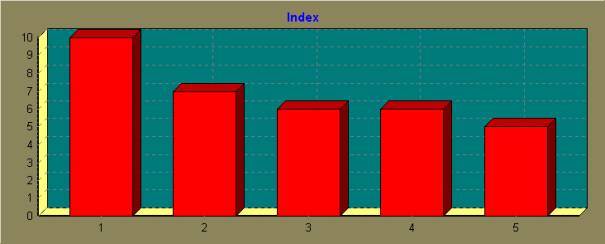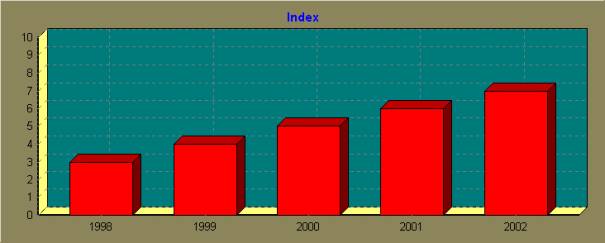|
Application of the biomonitoring-system
The main function of the system is the classification of forests according to their degree of disturbance, which includes human influence as well as natural events. This classification may be used for the comparison of different forests in an area.

Fig. 1: Comparison of 4 different disturbed forests of Amboró, Bolivia)
(1 = primary, 2 = logged, 3 = secondary, 4 = isolated trees)
Fig. 1 shows the comparison of four mountain forests in the Amboró National Park in Bolivia. The wide distribution areas of the indicators allow even the comparison of different lowland and montane forest types of different countries as in fig. 2 shown.

Fig. 2: Comparison of five logged forests from Bolivia, Ecuador and Peru
(1 = Sangay, Ecuador 1500m; 2 = Ríos Blanco y Negro, Bolivia 350m; 3 = Alto Mayo, Peru 1300m; 4 = Amboró, Bolivia 2000m; 5 = Manú, Peru 500m)
The program may also be used for long-term studies, e.g. for the control of conservancy strategies and forest management plans or the observation of forest-regeneration. Unfortunately within our project we had no time for long-term studies. Therfore, the example shown in fig. 3 is based on on dummy data.

Fig. 3: Regeneration of a forest (no real data)
How to obtain the field data
To obtain the data for the program, it is necessary to investigate several tree trunks from the forest floor (including buttresses) up to 2 m in altitude. Do not include species from the upper tree trunk (above 2 m) as this may change the index.
For most humid forests the study of 10 trunks is sufficient to get reliable results. It recommended to study 15-20 trunks for relatively dry and species-poor forests.
It is only necessary to look which indicators of the 34 indicator-species or indicator-groupsare present on how many trunks. The remaining species or the total number of bryophyte species are not required for the biomonitoring.
To get satisfactory results the consideration of the following recommendations for the fieldwork is essential:
|

|
Select trunks with a well-developed and species rich bryophyte vegetation. Some tree species show very poor developed bryophyte vegetation, due to certain characteristics of the bark (chemistry, structure) and should not be used.
|
|

|
Select trunks showing a bryophyte vegetation, which is typical for the investigated forest. Tree ferns, dead trees and in many cases palm-trunks possess bryophyte vegetation that is different from that of other trees and should therefore not be investigated.
|
|

|
If possible use older trees for the monitoring, unless you are working in young secondary forests. Young trees often possess a pioneer vegetation which may not be typical for the forest.
|
|

|
Plants apparently fallen down from the tree crown (not or very loosely attached to the trunk) should not be recorded.
|
|

|
Avoid gaps (natural or artificial) or borders of otherwise intact forest. Especially in primary forest maintain at least 20 m of distance to avoid border-effects.
|
|

|
The biomonitoring will not work in naturally very open forests, for example on steep slopes.
|
|

|
If the forest is very heterogeneous (common in logged forests) try to select trunks from different parts of the forest. With this data the program can calculate a “medium” index for the forest.
|
|

|
Always collect samples from the bryophyte vegetation of each trunk for study under microscope as small indicator-species (Prionolejeunea spp., Calypogeia spp.) are easily overlooked in the forest.
|
|
|

